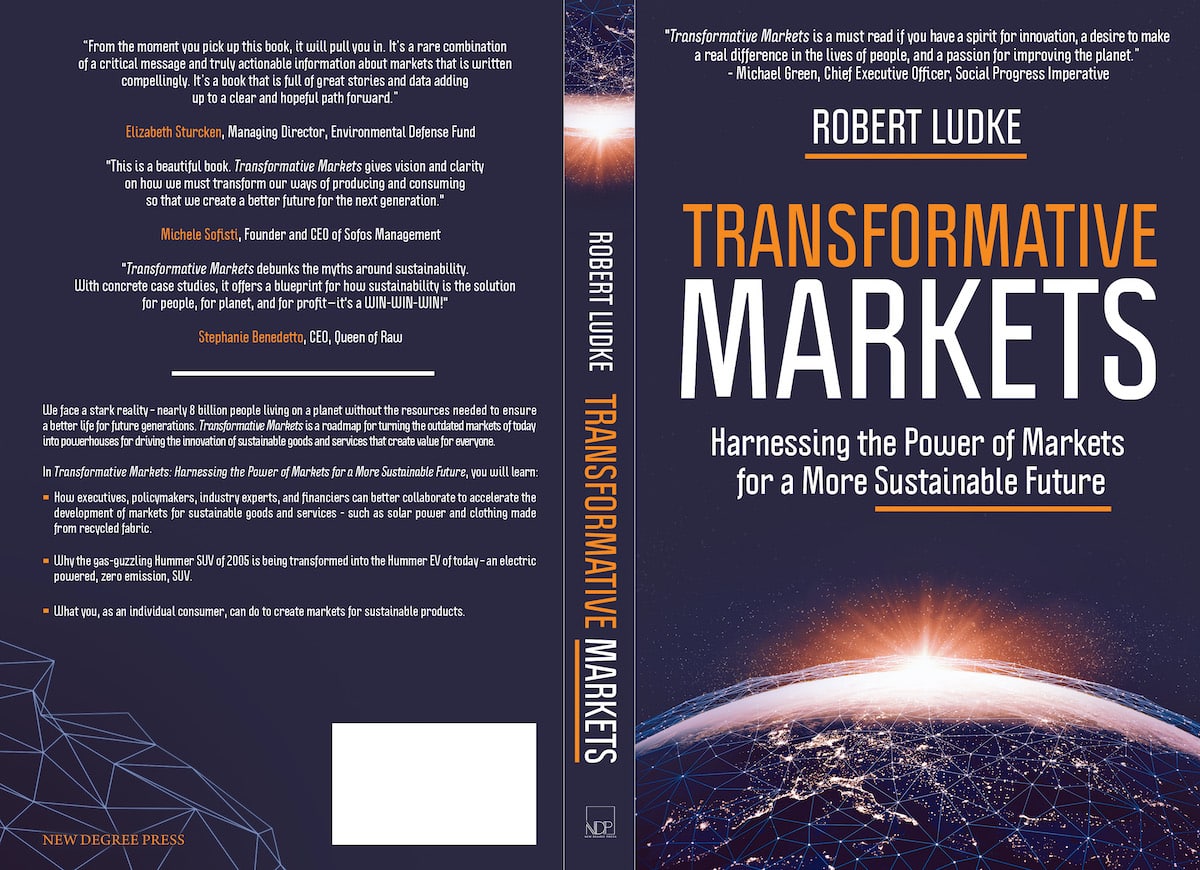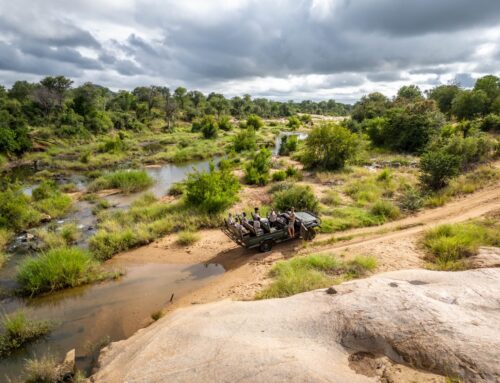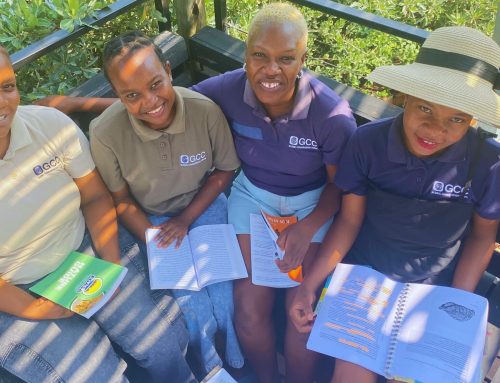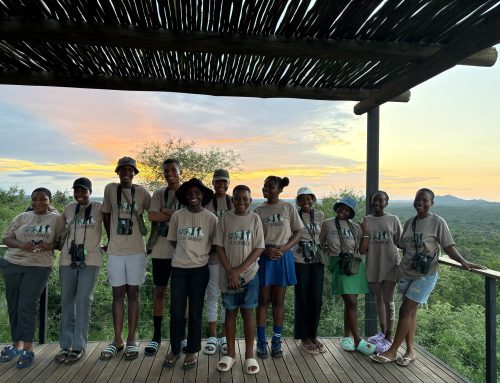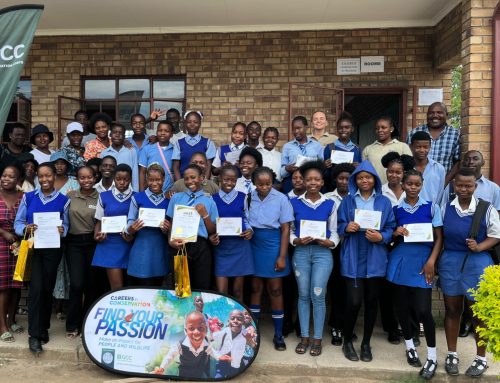Robert Ludke talks about his new book Transformative Markets and how sustainable practices don’t have to be a trade-off in terms of cost or quality.
Where did the idea come from to write a book about transformative markets?
The book is a combination of my professional life experiences. It began in a way when I was living in Kenya, almost 20 years ago, and I started to see hints that the climate was changing. The rainy season wasn’t quite as long as what it had been before and when it did rain, it rained really hard and it would wash away rather than soak into the soil. And that was before people started talking about climate change and global warming.
And then, when I came back to the US and entered into a career of consulting, I was helping businesses work on improving their environmental performance, reducing their pollution, cutting back on the consumption of various resources, devising ways to improve environmental performance and tracking financial savings. Pollution is a waste and waste costs money, and no business wants to waste money. So, it was the first time that I actually saw this really clear connection between doing something good for the environment that was also good for business.
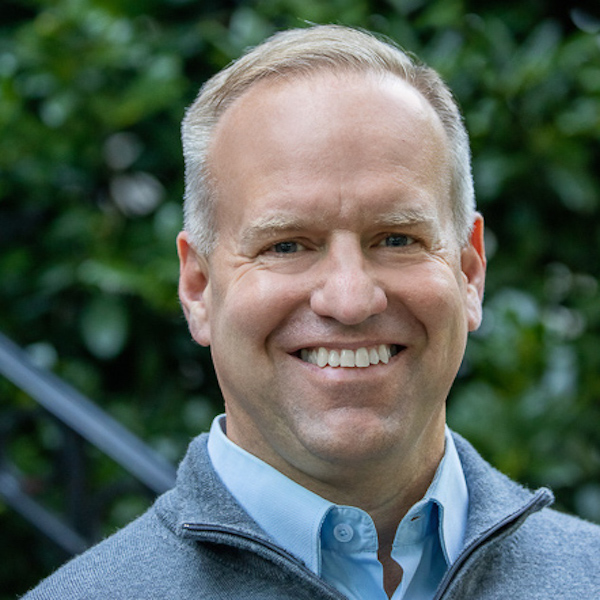
And then more recently I did some initial research for a client on the concept of sustainable markets and I discovered that no one had really looked at how these markets form, why some form and others don’t. So, when I had an opportunity to write a book during a program at Georgetown University in Washington DC, I immediately knew what my book topic was going to be.
You open the book with this really eye-opening mention of Earth Overshoot Day, the day each year when we use up our allowance of Earth’s natural resources. Last year the date was July 29th, which speaks volumes about our behavior. How worried should we be?
Worried is not a strong enough word, we should be terrified. The fact that in 50 years we have gone from a society in balance, where we used the level of resources that matched the Earth’s ability to regenerate those resources, to today where we are on an increasingly accelerating track of using more resources than the Earth can replenish. If you look at the trendline from these last 50 years, the only time you see the trend plateau, even just a little bit, is when there is a global economic recession like the Great Recession of 2008 and 2009. We are actually going to see it this year because of the terrible consequences of the pandemic and I think that this is maybe the most discouraging thing. The only way we slow down, even marginally, is in a time when human suffering increases. What this shows is that we have lost control of our ability to ensure that future generations live a better life. We value our present life today and we don’t really care what the future looks like because we are so absorbed with consuming whatever it is we want to consume today. The only way out of this is to completely change our mindset as customers, as individuals, and learn, at times, how to appropriately defer gratification.
Your book definitely offers hope with an easy-to-understand road map for change. Could you share a couple of things that companies can do to build sustainable markets within their business?
I think in terms of what a company can do the most immediate step they could take would be to invest in a really innovative start-up in its very early stages. We are talking about someone even working out of their garage, or with just a few employees, and it doesn’t have to be money – help them take this idea, or really small operation and scale it into something bigger. One example of this could be a big retailer moving the products that are made with recycled plastic from the bottom to the middle of the shelf, where they can give these companies, these ideas, these products, some space so that people can see them and they can take off.
So, at one level, there is this type of investment, and then more broadly, these companies need to start actually engaging with policymakers to create policy and regulatory frameworks to help the people with the innovative ideas scale their products to a level that actually make a difference in slowing down Earth Overshoot Day.
You touched on this earlier, but one of the messages in the book is how building sustainable markets doesn’t only make sense for the planet, but that is also good for business. Can you tell us about this?
My hope is that in this pandemic, we as a society, but also businesses, will take a look at how fragile their supply chains are and how risky the global business environment is. If you really start thinking about creating markets for sustainable goods and accessing more sustainable resources you can become a much more resilient business. You will be able to withstand the shocks of global disruptions, be it a pandemic, extreme climate and extreme weather, or the unfortunate circumstances of conflict.
In your research, were there any companies that really stood out as leaders in their field?
Let me answer your question a little differently. The one industry that stood out to me as the most passionate, the most determined, the most resilient, and the most determined was the clothing and fashion industry. There are these fairly young professionals who are completely reimagining the way the clothing and fashion industry functions. In that one segment of the economy, I found more inspiration than I did in almost any other industry that I researched in the book. These are people who are doing things like making moisture-wicking t-shirts out of recycled milk. The most influential person I found in the big-data methodology that I used to identify the most trusted actors in creating markets for sustainable goods and services is a woman by the name of Stephanie Benedetto. She is based in New York City and has created this online marketplace run on blockchain technology that is essentially a warehouse for unused or recycled fabrics that anyone else in the fashion industry can access. She is diverting tens of thousands of pounds of otherwise unused materials that would go into landfills to the making of clothing products anywhere around the world. What makes her so influential is that she is everywhere, she has partnerships with MIT, she is speaking at events, but she can back it all up with this incredibly substantive platform that she has developed. She is literally driving the conversation on how to use technology to divert products from landfills.
Are there any industries that are showing signs of positive change?
The industry I hold out the most hope for and the one that I think will be the most transformative is the automobile industry. First of all, Elon Musk and the Teslas have made energy-efficient, resource-efficient vehicles cool. Even big SUVs are now becoming battery-powered and are going to show the public that being sustainable is no longer a trade-off. You can get the same level of performance, perhaps even more performance, at the same cost as you would in a traditional vehicle, and that is going to start shifting the mindset around sustainable practices, that it is not always a trade-off in cost or in quality.
What surprised you the most during your research on the topic?
I think the most pleasant surprise is that when people collaborate, and by people, I mean organizations, policymakers, and consumers, these markets can form really quickly and they can make a difference. You look at how quickly the wind market in Texas grew because the policymakers in Texas had the foresight to establish the laws to allow investors to come in and invest, and now Texas is the fifth largest producer of wind power in the world.
You talk about how companies need to take responsibility for creating sustainable markets, but how can consumers help?
First of all, and probably the most important, they need to expect more and demand more both of themselves and of the producers of whatever products that they are consuming. And while a lot more needs to be done in terms of how we can empower consumers through education to be more sustainable in their purchasing decisions, it is a two-way street and we have to recognize that.
One thing that is important to mention is that you are donating all the proceeds of the book to the Global Conservation Corps, which is extremely admirable after all the time that went into it. Why was this important to you?
I am an advisor to GCC and that came about thanks to the long-time professional connection I have to Lee Godown, a board member of GCC. Lee knew that I had spent some time in Africa and when he heard about the book, and that I was in the final stages of writing it, he put me in touch with Matt Lindenberg and Josh Lumsden to talk about me advising GCC in some ways and lending my life and professional experience to the organization as it embarks upon a really impressive moment of growth. And as I came on board at GCC in early 2020 this was when I was finishing writing the book and one of the ideas that really stayed with me throughout the book is the concept of how you can scale a small idea into something much bigger if you partner and collaborate. So, in the conversations with the team at GCC, we came to an idea where we would add to the existing GCC curriculum on the Future Rangers program. We wanted to give students the opportunity – if they were interested in starting a business – to learn from the concepts of the book, presented to them by people who have actually started, built, and operated a business. This would be done in a way that is specifically designed to either protect or add to the precious ecosystem in South Africa, in particular around the Kruger National Park.
So, we want the students to eventually become business owners and make a profit and hire more people and pay them a good wage, but do so in a way that adds to the health and vibrancy of their community and of their immediate environment, rather than taking from it. And that’s the vision of the book too.
Order your copy of Transformative Markets in Paperback or on Kindle today to find out more about this important subject and support GCC at the same time. Stay tuned for an audio version of Transformative that will be released before the end of the year.
